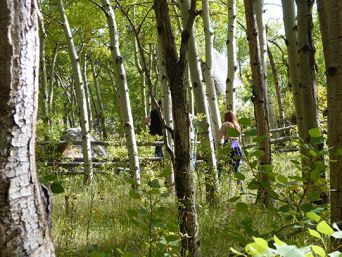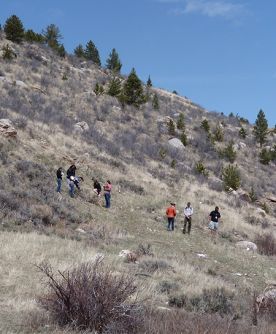Partnerships
The Biodiversity Institute is proud to have partnered with several schools and educators to develop lessons and units for their classes. Descriptions of several units are provided here. For more information about these, or to discuss implementation at your school, or development of new projects, contact Dorothy Tuthill. Additional lesson plans and ideas for using WyoBio can be found on the WyoBio Education Page.
Our Feathered Friends—a third grade unit on ecology and evolution
This 3-5 week unit, written by graduate student Anna Luhrmann, uses local birds to teach multiple Next Generation Science Standards (Variation in Traits, Natural Selection, Adaptation, and Biodiversity and Humans). The unit uses place-based education principles to inspire a sense of place and a connection to science in student’s daily lives. Students engage in exploration of their place by becoming familiar with local bird species, and develop an appreciation towards birds and their habitats. Divided into five lesson plans, the unit begins with an introduction to place and local species. Students learn how to identify birds and recognize the common birds of their home town, become familiar with bird adaptations, and the natural selection and variation of these traits, and take part in a project in which they become experts on a species. The unit culminates with an inquiry project to investigate how humans can have positive and negative impacts on birds and the environment, and students will learn that they can make a difference within their community. The unit was developed for 3rd grade, but can be modified for 4th or 5th grade.
This unit was piloted at Prairie Wind Elementary School, Cheyenne, Wyoming, in the spring of 2017.
You can access all of the lesson plans below
Genetic Structure of Aspen Groves in the Laramie Range

Based on their observations of the physical structure and location of the groves, students tested two hypotheses in the first year of the study:
1. All of the trees within a grove are genetically identical (a clone), and
2. Each grove is genetically unique.
A brief description of their methods and results can be found on their poster.
With each succeeding year (three now), new classes add more information to the discoveries of their predecessors. They are finding that the distribution of aspen genotypes requires complex interactions between landscape, reproduction and time.
Click here to read the report of student Kristina Edwards.
Ungulate Habitat and Multiple Use of Public Lands

This unit was developed by Charlie Vogelheim, an MS candidate at the Science and Math Teaching Center, for the Biodiversity Institute and Laramie High School.


This unit for fifth grade takes the study of ecology away from textbooks and into the field. Using place-based education, the best practices of English language learning (ELL), and young researchers at the University of Wyoming, this one-to-two month long unit meets multiple science standards.
The unit was developed by graduate student Paige Fisher, in collaboration with Little Snake River Valley School (Baggs, WY) teacher Jamie Litvinoff, the UW Science and Mathematics Teaching Center, the UW Department of Educational Studies, and researchers in the UW Program in Ecology and Department of Botany.
The entire unit (overview, nine lesson plans, and supplemental material) can be downloaded here.
Accompanying videos about current research at the University of Wyoming are available below.
For additional information, contact Dorothy Tuthill.

